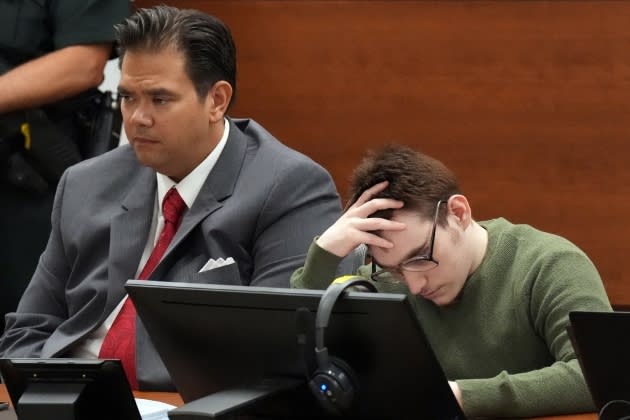‘His Brain Is Broken’: Parkland Shooter’s Lawyers Beg for Mercy in Opening Arguments

As the trial of Parkland school shooter Nikolas Cruz reconvenes in Florida, the defense has begun presenting its case to spare him the death penalty for the Feb. 2018 rampage at Marjory Stoneman Douglas High School that left 14 students and three staff members dead. Cruz, 23, pleaded guilty last October to 17 counts of premeditated murder and 17 counts of attempted murder for people he’d injured but who had survived. A jury will decide whether he deserves the death penalty.
In her opening statement on Monday, lead defense attorney Melisa McNeill argued that life in prison was sufficient punishment for Cruz, because, she said, he shows evidence of Fetal Alcohol Spectrum Disorder, and because there had been some missed opportunities for intervention throughout his troubled childhood – although she also described a slew of services and care he received from the school system, case workers, and counselors.
More from Rolling Stone
McNeill acknowledged Cruz has lately taken to using Atomic Fireball candies to scrawl “666” on the walls of his jail cell, and that Satan is his latest in a string of obsessions that has, throughout his life, included tigers, video games, exercise, bowel movements, vegan diets, and guns. “These are the things he does in isolation,” she said. “We’re not hiding that from you. But his brain is broken. He’s a damaged human being.” She told jurors that the law never requires them to vote for a death penalty, even in the worst case imaginable. “It’s arguable that this is the worst case imaginable,” she said, but urged the jury to consider the mitigating factors of Cruz’s troubled past.
As Cruz sat beside his other attorneys, wearing thick glasses and a dark sweater vest over a white shirt, McNeill presented the defense team’s take on the making of a dangerous killer. She focused the beginning of her 90-minute argument on Cruz’ biological mom’s substance abuse during her pregnancy. “Nikolas Cruz’s prenatal vitamins consisted of Colt 45, Cisco Bum Wine, crack cocaine, and cigarettes,” she said. “He was poisoned in the womb. And because of that, his brain was irretrievably broken, through no fault of his own.”
She also laid out his history of developmental, behavioral, academic, and social struggles, starting from a very young age. Cruz received specialized education and therapeutic treatment from pre-school onward, but McNeill said the only time he got the level of structure and support he needed was when he attended a therapeutic school staffed by clinicians and behavioral specialists — a school that he earned permission to leave through good behavior, because he wanted to attend the mainstream Marjory Stoneman Douglas High School. On the day in Feb. 2017 that Cruz got kicked out for low performance, having lost his special needs services when he turned 18, McNeill said a monitor watching him run away from the campus said, “That kid is gonna come back and shoot this school up.”
At times, McNeill laid blame on Cruz’s adoptive mother, Lynda Cruz, who died three months before the shooting. Lynda had indulged Cruz’s firearms obsession by buying him a BB gun and an airsoft gun, against the guidance of a psychologist, she said, and later taking him to buy his first real gun when he was in high school. She also claimed Cruz could have received better treatment by therapists and educators if Lynda had been more forthcoming about his exposure to alcohol in utero. She also said Lynda had declined to admit Cruz to a residential treatment facility because she would lose her social security benefits if she did.
McNeill said jurors would hear from Cruz’s sister Danielle Woodard, a former “drug buddy” of his biological mother’s, multiple counselors, and teachers being forced to testify under subpoena about their attempts to intervene in Cruz’s disturbing behaviors. McNeill said one teacher who tried to stop him from attending Stoneman Douglas was told to “stay in her lane.”
The prosecution rested their case on Aug. 4, after which court took a brief recess and then held hearings without the jury present. During the prosecution’s case, 12 jurors and 10 alternates spent three weeks viewing harrowing videos from the crime scene, listening to autopsy evidence, and hearing statements from the 17 victims’ friends and family. Families described how holidays have become impossible to celebrate, how one parent sprays her daughter’s perfume sometimes to feel close to her, how a father struggles to comfort his son, who survived the shooting, while his daughter did not. Family members of victims in the gallery cried and held each other. At one point, parents of a victim shouted “Shut it off” when jurors were shown a cell phone video from the shooting with the sounds of gunshots and children screaming. During portions of the testimony, Cruz’ defense lawyers dabbed their eyes.
The prosecution concluded its case with a tour of the crime scene, the freshman building at Stoneman Douglas, which was closed to the public but has remained largely untouched since the shooting four years ago. Walking through the halls, jurors saw walls marked with blood and bullet holes, Valentine’s Day cards and dried rose petals, shattered glass, laptops left open, and classroom assignments left unfinished.
In his opening statement on July 18, lead prosecutor Michael Satz said he planned to show that seven aggravating factors warranted the death penalty in this case, including that Cruz had knowingly created a great risk of death to many people; that the murders were especially heinous, atrocious or cruel; and that they were committed in a cold, calculated, and premeditated manner without any pretense of moral or legal justification.
According to Florida law, a death sentence requires unanimous recommendation from the jury. If even one juror disagrees, Cruz will instead be sentenced to life in prison without the possibility of parole.
This story has been updated to include details from the opening statements.
Best of Rolling Stone
